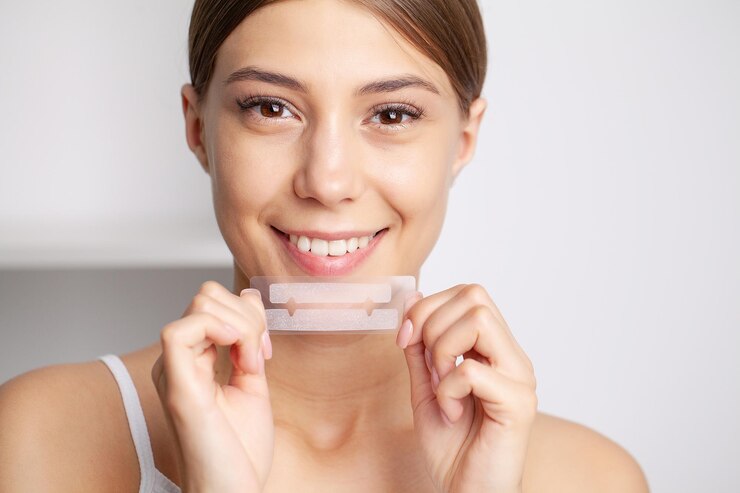
Porcelain veneers are a popular choice for anyone looking to achieve a flawless, radiant smile. If you’ve invested in veneers, you know how important it is to keep them looking bright and beautiful. But with so many teeth-whitening products on the market, it can be tempting to reach for whitening strips to enhance your smile further.
Before you do, though, you might wonder – are whitening strips safe for porcelain veneers?
The answer isn’t as simple as a yes or no. Whitening strips work wonders on natural teeth, but veneers are a different story. Understanding how whitening products interact with veneers is crucial to avoid potential damage or an uneven smile.
In this guide, we’ll dive into everything you need to know about whitening strips and veneers, so you can protect your smile and make the best decisions for your dental health.
What Are Porcelain Veneers Made Of?
Porcelain veneers are crafted from thin, durable layers of porcelain, designed to mimic the appearance of natural teeth while offering long-lasting cosmetic benefits. Unlike natural enamel, porcelain is non-porous, meaning it doesn’t stain or discolor easily. This makes veneers an excellent option for maintaining a bright, white smile over time, even when consuming staining foods or drinks.
- Porcelain is highly resistant to staining, unlike natural teeth, which are more prone to discoloration.
- The material offers superior durability, ensuring veneers can last for many years with proper care.
- Veneers are custom-made to match the exact shape, size, and color of your natural teeth, blending seamlessly.
- They maintain their color over time, unlike natural teeth, which can yellow with age or lifestyle habits.
- While they mimic the natural look of teeth, they require special care to prevent damage or premature wear.
How Whitening Strips Work on Natural Teeth
Whitening strips contain bleaching agents, usually hydrogen peroxide or carbamide peroxide, that penetrate tooth enamel to break down stains. This process works well on natural teeth because enamel is porous and absorbs these agents, lifting surface stains to reveal a brighter smile. However, this whitening action doesn’t work the same way on porcelain veneers.
- Whitening strips target stains that have built up on the surface of natural teeth, making them whiter over time.
- The peroxide penetrates the enamel, breaking down discoloration that has accumulated from foods, drinks, and smoking.
- Veneers, made from porcelain, are non-porous and cannot be lightened by the same process as natural teeth.
- Using whitening strips on veneers will not improve their color and can even lead to uneven results if applied to both veneers and natural teeth.
The Effects of Whitening Strips on Porcelain Veneers
While whitening strips can brighten your natural teeth, they don’t have the same effect on porcelain veneers. Since the bleaching agents in whitening strips don’t penetrate porcelain, using them can result in an uneven smile—where your natural teeth become whiter, but your veneers stay the same color. This contrast can look unnatural and disrupt the overall balance of your smile.
- Whitening strips cannot alter the color of porcelain veneers, as the material does not absorb bleaching agents.
- Applying whitening strips can lead to uneven color between veneers and natural teeth, creating an unnatural appearance.
- Overuse of whitening strips can cause irritation to the gums or damage the enamel of the surrounding natural teeth.
- Professional cleaning and polishing are safer methods for maintaining the brightness of veneers without the risks of whitening strips.
How to Whiten Porcelain Veneers Safely
While whitening strips aren’t suitable for veneers, you can still maintain their brightness and appearance through other methods. Professional dental cleanings are one of the best ways to ensure your veneers stay radiant. Dentists can also polish veneers to restore their shine and remove surface stains that may build up over time.
- Visit your dentist regularly for professional cleanings that maintain both your veneers and natural teeth.
- Specialized veneer-safe polishing treatments can help enhance the brightness of your veneers.
- Avoid DIY whitening products; always consult with your dentist about veneer-friendly options.
- Practice good oral hygiene by brushing and flossing daily, as plaque buildup can dull the appearance of veneers.
If you’re in need of dental veneers in Springfield, MO, talk to a local dentist who specializes in maintaining veneer treatments without risking damage to your smile.
Key Maintenance Tips for Long-Lasting Veneers
Taking care of your porcelain veneers involves more than just keeping them clean – you need to follow a few key habits to maintain their long-lasting appeal. Proper care can help you enjoy your bright, polished smile for years to come. Avoiding certain foods and drinks, and sticking to a solid oral hygiene routine, will preserve their appearance.
- Brush and floss daily to prevent plaque buildup that can dull your veneers’ shine.
- Limit consumption of staining foods and drinks like coffee, red wine, and dark berries to avoid surface discoloration.
- Avoid habits like chewing on ice or biting hard objects, which can crack or chip veneers.
- Use a soft-bristled toothbrush and non-abrasive toothpaste to clean your veneers without scratching them.
- Visit your dentist regularly for checkups and cleanings to ensure your veneers remain in great shape.
Porcelain veneers can elevate your smile, but maintaining their brilliance requires the right approach. While whitening strips won’t work on veneers, regular dental care and professional treatments keep them looking their best. Consult your dentist for the safest and most effective ways to care for your veneers and avoid DIY whitening products that could cause harm. With the proper care routine, your veneers will continue to brighten your smile for many years to come.
